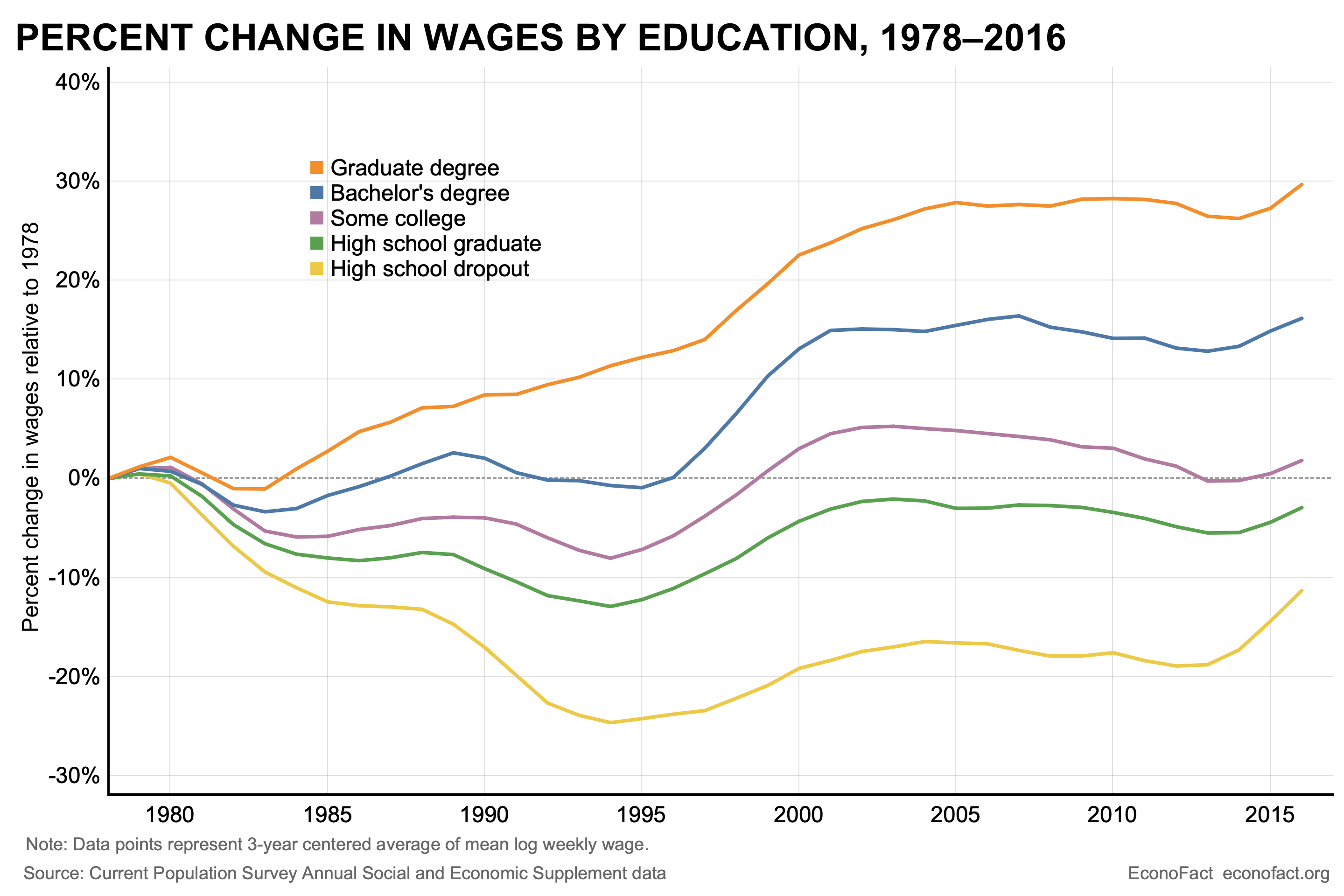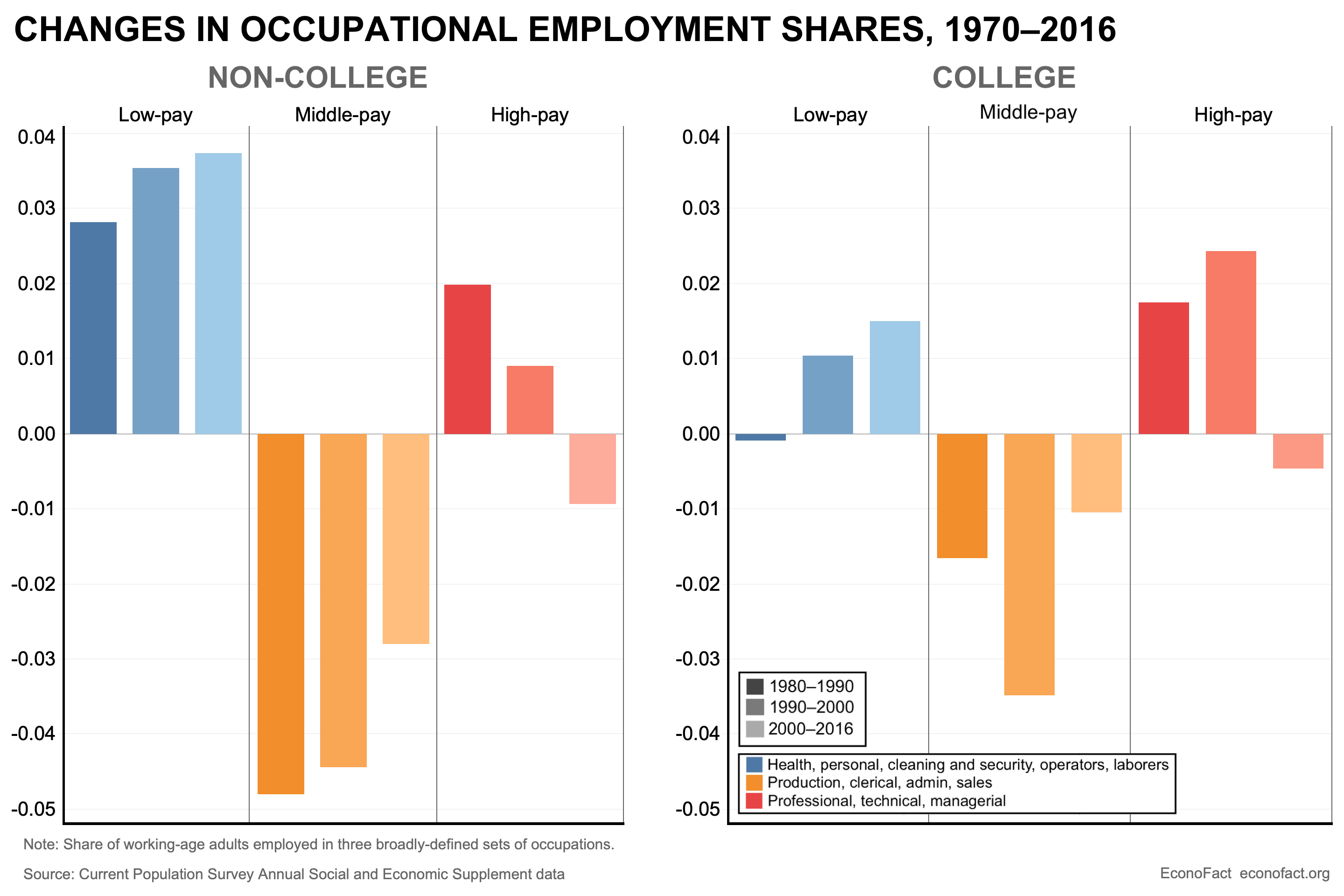The Shrinking Share of Middle-Income Jobs
MIT and NBER
(Click here for a larger version).
The Issue:
Over the past four decades, less-educated workers, particularly non-college men, have experienced an actual fall in their real earnings (that is, after adjusting for inflation). An important reason for this decline in the earnings among low-income workers is the shifting structure of occupations, with a hollowing-out of what had been middle-income jobs. This is especially true in urban and metropolitan areas, places where there had been good job opportunities for those without a college education but, increasingly, the jobs available to those with a high school education in these places are in low-paid occupations with little opportunity for upward mobility.
The decline in jobs that provided middle-class wages for those with less than a college education has contributed to rising wage inequality.
The Facts:
- Rising wage inequality is a well-documented characteristic of the U.S. labor market over the past 40 years; but such divergence in earnings was not a feature of the preceding decades. The post-World War II period can be divided into three eras with respect to the distribution of wages. The period from immediately after World War II until 1972 was a time when wages were rising evenly for people with all levels of education. In contrast, the period that began with the first oil shock in 1973 through the end of the 1970s saw inflation-adjusted earnings stagnate across the board. Subsequently, beginning in 1980 and continuing to the present there has been rising wage inequality, with wages rising robustly for the most educated and falling, in real terms, for the least educated. This is especially striking because the supply of highly-educated workers has increased while that of less-educated workers has declined; the share of hours worked by those without a college degree fell from 75 percent in 1963 to less than 40 percent in 2017 while over the same period the share of hours worked by those with a bachelor's or post-college degree rose from less than 15 percent to more than 35 percent.
- An important source of these shifts in wages and hours is the hollowing out of middle-income jobs. While there are a range of reasons for the decline in wages and hours worked for those with less than a college education (including eroding union power, rising trade in manufacturing goods from low-labor-cost countries, and falling real values of minimum wages), an important reason that has not had as much attention is the decline in jobs that had provided middle-class wages for those with less than a college education. The shrinking share of these middle-income jobs appears as a "barbell effect" with the decline of middle-paid jobs contrasted by the rise in the employment share for both lower- and higher-paid jobs (see chart). Employment can be sorted into three broadly defined sets of occupations: those with typically low pay and education requirements that require little specialized skills or training (health aids and personal services, cleaning and security, and operators and laborers); middle-paid occupations that do not necessarily demand a four-year college degree but do require specialized skills (production workers, office/administrative workers, and sales workers); and high-paid occupations that typically require a four-year degree (technicians, professionals, and managers). In 1980, non-college workers were evenly split between low- and medium-paid occupations (at 42 percent and 43 percent, respectively) and the remaining one-seventh of workers without college degrees were in traditionally high-paid occupations. By 2016, the share of non-college educated workers in mid-pay occupations had fallen to 29 percent, with about 12 of the overall 14 percentage point decline representing a shift to the low-paid category and less than a 1.5 percentage point increase in the high-pay category. Over this same period, there was a more modest barbell effect for college-educated workers, with those in the mid-pay occupations declining from 27 to 20 percent, those in high-pay occupations rising from 57 to 61 percent, and those in low-paying occupations rising from 16 to 19 percent.
- There are technological, global and institutional reasons why this "barbell effect" was concentrated among workers in urban and metropolitan areas. In the 1950s and 1960s, workers in urban areas who did not have college degrees disproportionately held middle-education, middle-income, blue-collar production jobs and white-collar office, administrative and clerical jobs as compared to workers in suburban and rural areas. These jobs involved close collaboration with more highly-educated professional, managerial and technical workers who oversaw factories and offices. This collaboration benefited workers holding these middle-income jobs since their value to their companies was enhanced by high-education coworkers. But starting in the 1970s, the demand for mid-education urban workers declined due to rising automation in factories, greater use of computers and information technology in offices, and greater pressure from international trade. Workers without a college degree moved from middle-income occupations to those that traditionally require less education and offer lower wages – and because middle-income jobs for those without a college degree were more prevalent in urban and metropolitan areas, this had a proportionally bigger effect in those places.
- The shifting of workers across occupations, and the gradual disappearance of certain types of jobs from urban areas has had important economic consequences. There has been a marked difference in the trajectories of wages for workers with different levels of education between 1978 and 2016 (see line chart below). Part of the overall relative (and absolute) decline in wages going to workers with a given level of education between 1980 and 2016 is due to the movement of these workers to lower-paid occupations, the hollowing-out effect described above. But this by itself accounts for only part of the actual change – a more complete picture reflects changing wages within each type of occupation which, in turn, reflects the changing geographic distribution of occupations since workers in urban and metropolitan areas earn more than those elsewhere who are in similar occupations. Middle-income, middle-education jobs have been moving out of urban areas; in 1970 urban areas had about 15 percentage points more middle-education jobs than rural areas, and this difference was 25 percentage points for middle-education jobs held by those with a high-school education or less. These geographic differences disappeared by 2015. The result is a profound reallocation of urban workers with a high-school education or less from middle-income production and office work jobs to lower-paid services, transportation and laborer occupations that has had important implications for wage inequality and for the absolute decline in the real value of wages for those who do not have a high school degree or do not have education past high school.

- Wage polarization has been more adverse for minority workers without a college degree, since they are overrepresented in urban areas and had benefited from middle-income jobs. At present, only 36 percent of U.S. adults over the age of 24 have a four-year college degree, and this fraction is considerably lower among Blacks and Hispanics than among whites and Asians, and lower still among minority men, according to 2020 Census data. By implication, two-thirds of adults fall outside the education category— college or above — that has seen robust earnings gains over the last four decades. For Black and Hispanic men, the share that is ineligible is higher still, between 75 and 80 percent. The low-wage jobs that are prevalent in urban areas, like personal services, food services, cleaning, home health aides and security, are also less secure and offer fewer non-wage benefits.
- Other industrial countries that faced similar technological changes and international competition have not seen the same rise in inequality. Many European countries have seen the same barbell effect in their occupational structures, with a relative loss of jobs with mid-level requirements. However, low-paid service occupations in most of Europe offer relatively higher pay, greater security, and far more generous benefits — including paid vacation, sick time, and family leave — than in the United States. Although these countries are not wealthier than the U.S., inequality is lower, real wages are higher at the bottom of the distribution, and greater non-wage benefits are guaranteed due to collective bargaining or regulation.
What this Means:
The hollowing out of middle-education, middle-income jobs for those without a high school education, jobs that were once abundant in urban and metropolitan areas, has been an important source of wage stagnation for those without a college degree and has contributed to widening wage inequality. There is unfortunately no simple fix to a problem that has been allowed to metastasize over four decades. Policies like higher minimum wages, better labor standards and even an expansion of government spending in areas that would create more middle-education, middle-income jobs — such as renewed infrastructure investment — will help on the margin. But a broader effort will be needed to restore opportunity for the vast majority of workers who lack a college degree. One promising step in this direction would be for employers to relax some of the college credential requirements that have proliferated even for traditionally non-college jobs in office work, manufacturing, and even construction. Tight labor markets, together with the fact that workers with a college degree have become increasingly pricy in recent decades and a recognition that imposing college credential requirements substantially thwarts efforts to diversify professional workforces, give employers an incentive to audition and train workers for positions that, in slacker times, might have gone to a candidate with a bachelor's degree. A shift towards employers using “skills-based” rather than credential-based hiring does not negate the importance of raising educational attainment over the long run, particularly among groups that have historically not been well-served by our higher-education system. Simultaneously, it is both inefficient and inequitable to squander the capabilities of the workers of the present, many who completed their formal education a decade or two ago.
Like what you’re reading? Subscribe to EconoFact Premium for exclusive additional content, and invitations to Q&A’s with leading economists.

